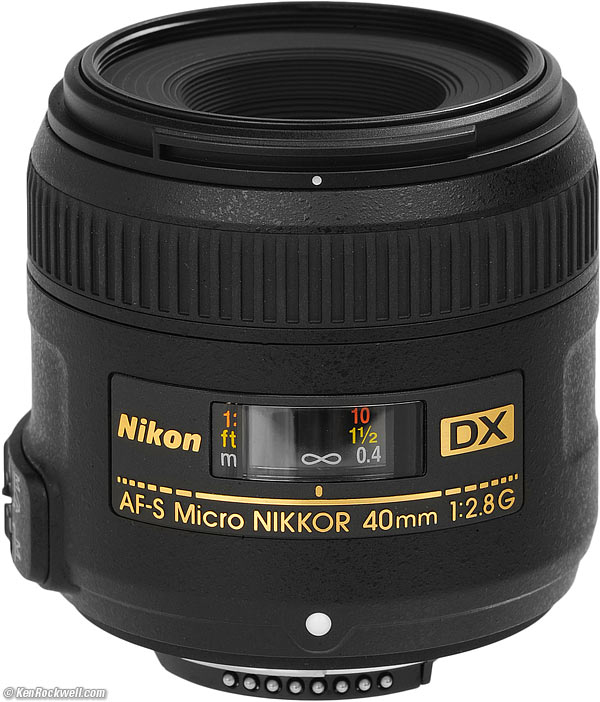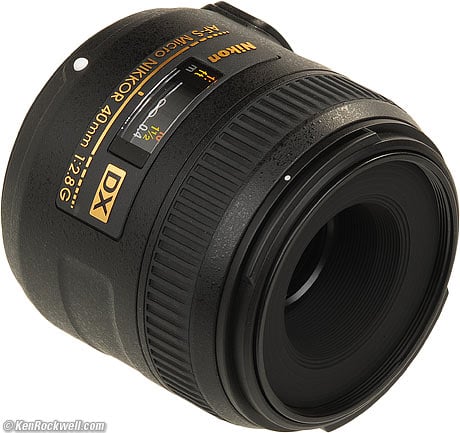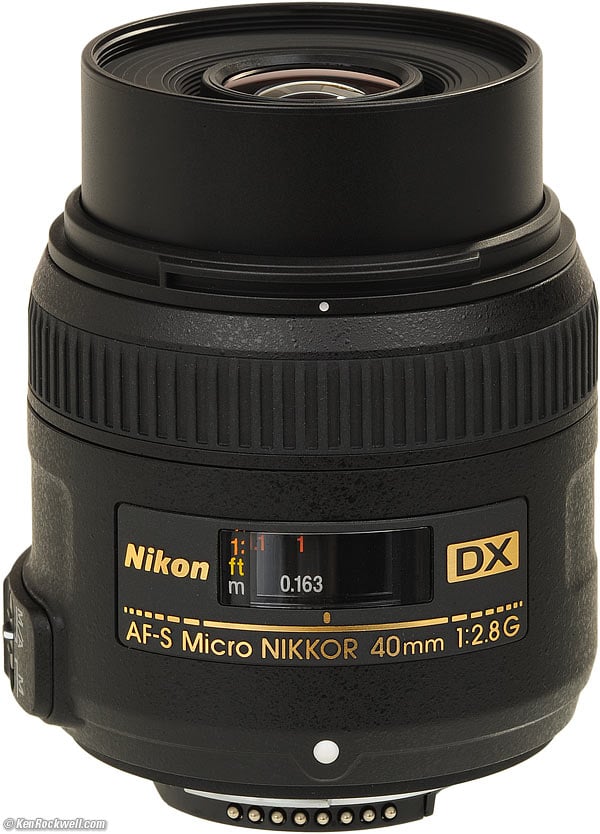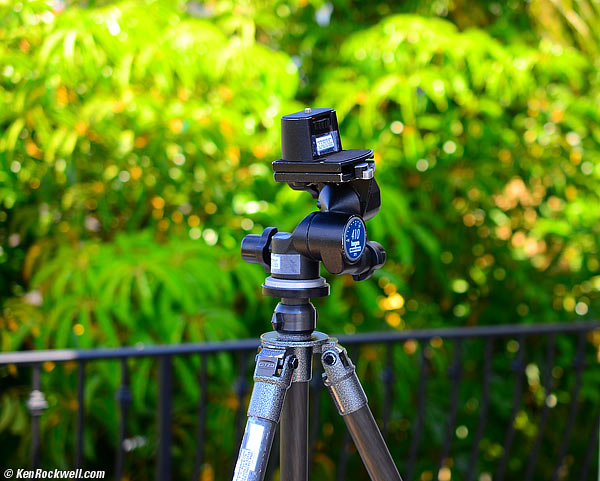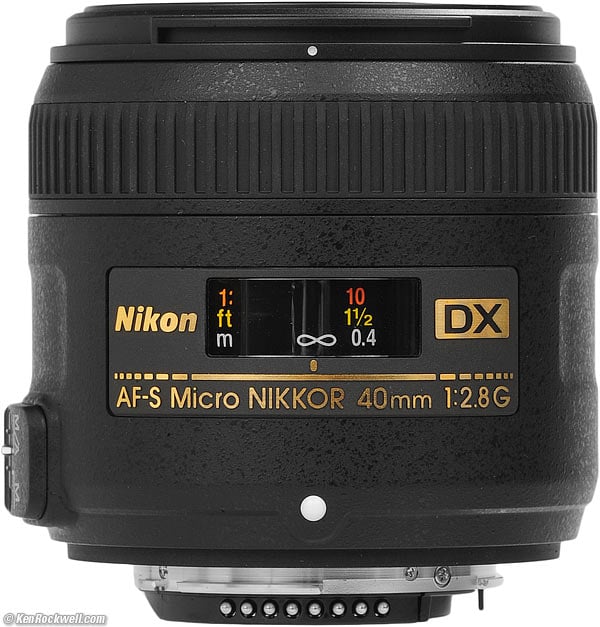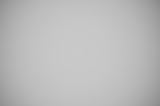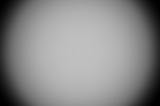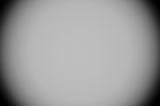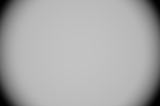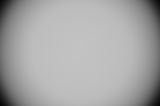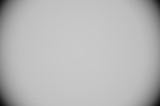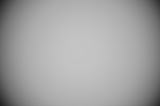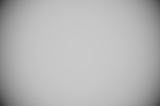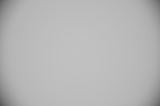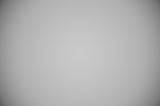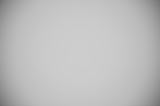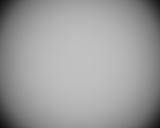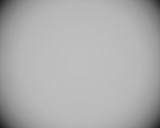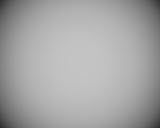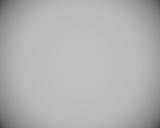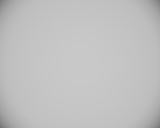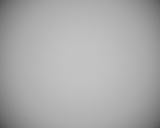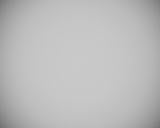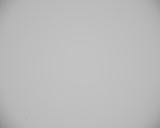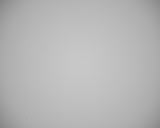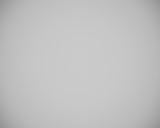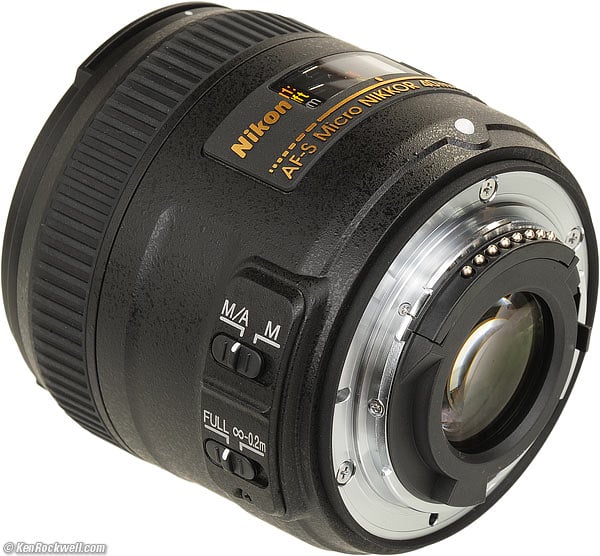Home Donate New Search Gallery Reviews How-To Books Links Workshops About Contact
Nikon 40mm f/2.8 G
DX Micro-NIKKOR (DX-only)
© 2013 KenRockwell.com. All rights reserved.
How to Shoot Macro Best Macro Lenses Compared
Intro Specifications Performance Compared Usage Recommendations
Nikon 40mm f/2.8 DX G AF-S (52mm filters, 8.0 oz./227g, 0.5'/0.163m (1:1) close focus, about $280). enlarge. The biggest source of support for this free website is when you use these links, especially these links directly to it at Adorama or at Amazon, when you get anything, regardless of the country in which you live. Thank you! Ken.
June 2013 Nikon Reviews Nikon Lens Reviews Other Reviews
| Optics: | |
| Mechanics: | |
| Ergonomics: | |
| Usefulness: | |
| Availability: | |
| Overall: |
Ideal for: Perfect for use on DX digital as a normal lens that also can get really close when occasionally needed.
Not for: Does not work on FX or 35mm. Not a good idea for serious macro use; get a 105mm or 200mm macro lens for that.
Introduction top
Intro Specifications Performance Compared Usage Recommendations
|
Adorama pays top dollar for your used gear. I use these stores. I can't vouch for ads below. |
The Nikon 40mm f/2.8 DX Micro is a great little all-purpose normal lens for DX cameras that also can focus super-close.
The Nikon 40/2.8 DX is ideal for general photography as a normal lens, especially if you expect occasionally to need to get closer than one foot. "Micro" is Nikon's word for macro; I'll use these words interchangeably.
You may grab the focus ring at any time for instant manual-focus override.
If you don't need to get closer than 1 foot, the Nikon 35mm f/1.8 DX is more than twice as sensitive to low light and costs $80 less than this 40mm lens. Unless you need to get super-close, get the 35mm f/1.8 DX.
If you want to do serious macro work, any 40mm lens is a bad idea because you have to get too close to your subject to get close-ups. You'll block your light and your pictures will show the subject from an unnaturally close point-of-view. At its closest, there will be only 1.3 inches (35mm) between the front of this lens and your subject!
40mm macro lenses are most useful for slide copying where the light comes from behind. That's why this 40mm lens is mostly for use as a general-purpose normal lens, with the ability to focus very close for occasional use.
If you want to do serious macro work, you'll be much happier using the fast 35/1.8 for general use, and putting the $80 saved towards a used 105mm f/4 or 105mm f/2.8 manual-focus lens. Serious macro work is done manual-focus anyway. Also consider the awesome Tokina 100mm f/2.8 AF Macro.
If money isn't an issue, get the 105mm VR macro, or the 200mm f/4 Micro-NIKKOR, which is the very best macro lens there is and the one I use daily.
All said and done, this is a spectacular lens, so long as macro isn't your main reason for getting it.
Nikon 40mm f/2.8 DX. enlarge.
Note how the optics retract inside the barrel when focused at infinity.
Everything works perfectly on every DX Nikon, even on Nikon's cheapest digitals like the D40, D40x, D60, D3000, D3100, D5000 and D5100.
You'll get dark or black corners if you try to use this lens on FX or 35mm cameras, and without an aperture ring, may not be able to meter or set exposure on older 35mm cameras anyway.
See Nikon Lens Compatibility for details with your camera. Read down the "AF-S, AF-I," and "G" columns. You'll get the least of all the features displayed in all columns, since "G" (gelding) is a deliberate handicap which removes features.
Specifications top
Intro Specifications Performance Compared Usage Recommendations
Name top
Nikon calls this the Nikon AF-S DX Micro NIKKOR 40mm f/2.8G.
AF-S and SWM: Silent Wave Autofocus Motor.
DX: Won't work well on film or FX cameras.
Micro-NIKKOR: Nikon macro lens.
G: Gelded for cost-reduction and removing compatibility with older cameras.
Optics top
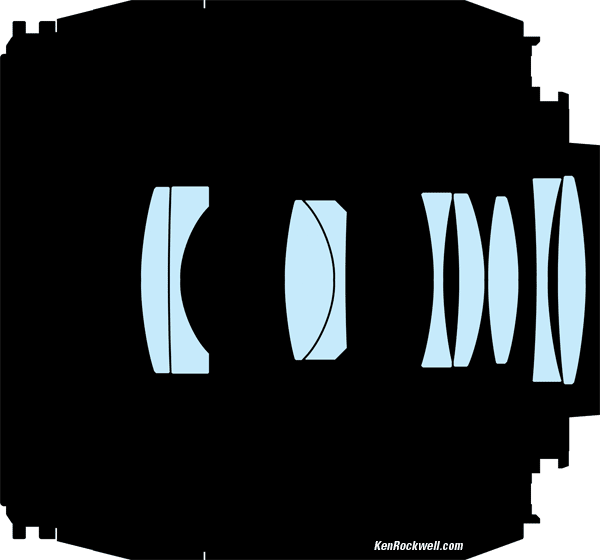
Nikon 40mm f/2.8 DX.
9 good old-fashioned spherical elements in 7 groups.
Floating elements: the rear group is fixed while the front groups move forward to focus more closely. The front groups move far forward, and the front of the lens extends, too.
It's multicoated, which Nikon calls Nikon Super Integrated Coating.
Diaphragm top
Nikon 40mm f/2.8 DX at f/22 at infinity. enlarge.
7 semi-rounded blades.
Stops down to f/22.
Coverage top
DX only.
For 35mm film and FX, get the Nikon 60mm f/2.8 G or Nikon 60mm f/2.8 AF-D instead.
Focal Length top
40mm.
When used on a DX camera, it gives angles of view similar to what a 60mm lens gives when used on an FX or 35mm camera.
Angle of View top
38.8° on DX.
Close Focus top
0.53 feet (6.4 inches, 0.163 meters or 163 millimeters) from the image plane (the back of the camera).
Working Distance top
While the close-focus distance is 6.4 inches from the image plane, the lens obviously pokes ahead of the camera.
Nikon 40mm f/2.8 DX at closest focus distance. enlarge.
Worse, the front extends as you focus more closely, leaving only 1.3 inches (3.5cm) between the lens and your subject at 1:1!
This is why this 40mm lens is a horrible idea for serious macro work — it gets in its own way!
Notice how the front elements have moved far forward at 1:1.
Maximum Reproduction Ratio top
1:1, meaning something 16 x 24mm (0.65 x 1 inches) will fill the DX frame.
Hard Infinity Focus Stop? top
No.
You have to let the AF system focus at infinity.
Focus Scale top
Yes, but very basic.
Depth-of-Field Scale top
No.
Infra-Red Focus Index top
No.
Aperture Ring top
No.
Filter Thread top
52mm, plastic.
Does not rotate.
Size top
68.5 long × 64.5 mm diameter.
2.7" long × 2.5" diameter.
Weight top
8.015 oz. (227.2g), measured.
Nikon rates it as 8.3 oz. (235g).
Hood top
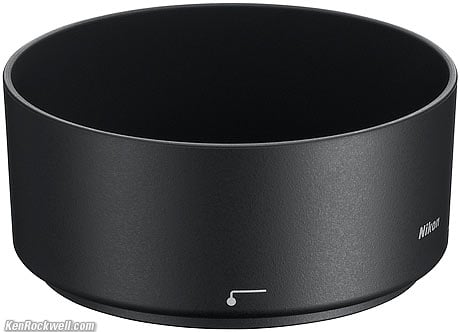
HB-61 Hood for Nikon 40mm f/2.8 DX G AF-S.
Plastic bayonet HB-61 hood, included.
Sack top
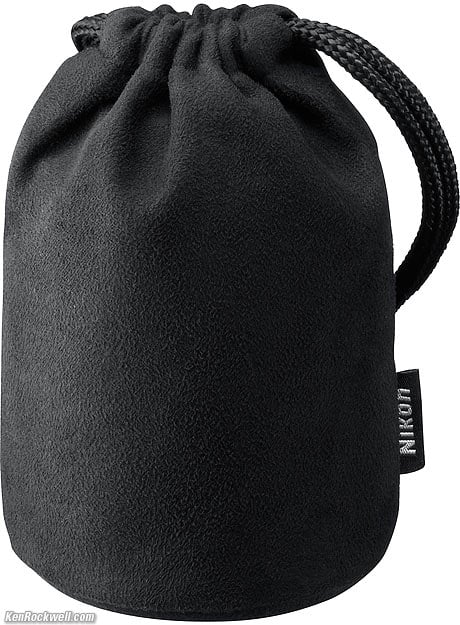
CL-0915 Sack for Nikon 40mm f/2.8 DX G AF-S.
CL-0915 sack included, but a used sock works better.
Included top
LC-52 snap-on front lens cap.
LF-4 rear cap, the one with the fatter rim to keep dust off the mount.
HB-61 plastic hood.
CL-0915 sack.
Quality top
Made in The People's Republic of China.
Announced top
12 July 2011.
Available top
Started shipping in early September, 2011.
Price top
USA: $279.95,
Australia: $449 RRP, available 25 August 2011.
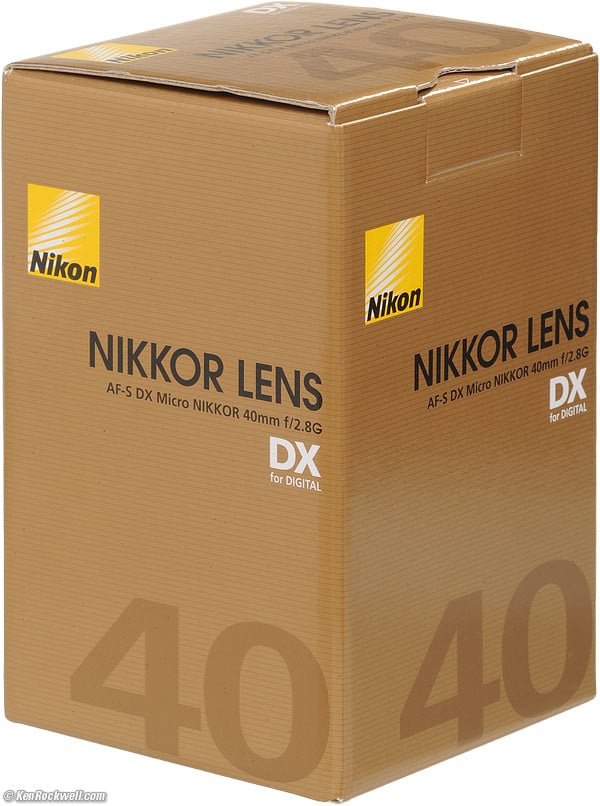
Box, Nikon 40mm f/2.8 AF-S G DX.

Serial-numbered bag holding lens inside cardboard inside box.
Performance top
Intro Specifications Performance Compared Usage Recommendations
Overall Autofocus Bokeh Color Coma Distortion Ergonomics
Eyeblow Falloff Filters Flash FX, use on Hood
Lateral Color Fringes Macro Maximum Aperture Mechanics
Sharpness Sunstars Survivability
Overall performance top
The Nikon 40mm f/2.8 DX G AF-S is an extremely sharp and inexpensive lens.
Nikon's Image Sample 1: Stream
Nikon's Image Sample 2: Bokeh Girl
Nikon's Image Sample 3: Knickknack Bokeh
Nikon's Image Sample 4: Out-of-Focus Food
Nikon's Image Sample 5: A cat (give me a break!)
Autofocus performance top
Overall
Autofocus is fast and accurate.
AF Speed
AF speed is fast, even if it has to rack back and fourth between infinity and close distances.
AF Accuracy
On my D7000 and D3 it was always dead-on.
Manual Focus
Manual focus is great. Just grab the ring at any time, no need to move any switches — unless you want to lock it into manual focus mode.
M/A - M Switch
Nikon goofed. This switch is supposed to be labeled "A - M."
The "M/A" position means autofocus. It's called "M/A" because you also can focus manually simply by grabbing the focus ring in this position.
The "M/A" position means autofocus. It's called "M/A" because back in the old days, when Nikon had almost caught up to Canon who had been doing this for ten years before, Nikon was trying to show off that you could focus manually while in the AF position.
Paint over the extra M if you're easily confused.
Bokeh performance top
Bokeh, the character of out of focus backgrounds, not simply how far out of focus they are, is very good. Blur circles are even and have soft edges.
Here's a shot on my Nikon D7000:
Rockwell's tripod and 3275/410 geared head at f/2.8 on DX. enlarge.
Color Rendition performance top
The color rendition of this 40/2.8 DX lens appears to match all my other modern NIKKORs.
Coma performance top
I can't see any coma (saggital coma flare) on a 16MP D7000.
Distortion performance top
The Nikon 40 DX has no visible distortion.
For more critical scientific analysis, plug these figures into Photoshop's lens distortion filter. These aren't facts or specifications, they are the results of my research that requires hours of photography and calculations on the resulting data.
FX and Film |
||
10' (3m) |
-0.5 |
|
1:10 |
0.0 |
-2.0 |
1:3 |
-0.5 |
|
1:1 |
-1.0 |
© 2011 KenRockwell.com. All rights reserved.
Ergonomics (handling and ease-of-use) performance top
Nikon 40mm f/2.8 DX. enlarge.
Ergonomics are great; just grab and go.
The focus ring feels great, and you may grab it at any time for instant manual-focus override.
If you want to lock the lens into manual focus, just move the switch which falls right under your thumb.
Eyeblow performance top
As the 40/2.8 DX focuses in and out, some air pumps in and out of the mount via the diaphragm actuation pin, but I never noticed any coming out of my D7000's eyepiece.
Falloff (darkened corners) performance top
Falloff on DX is negligible, and completely gone by f/4.
I've greatly exaggerated it here by shooting a gray field and placed the images against a gray background:
Nikon 40mm f/2.8 DX falloff on DX, no correction.
© 2011 KenRockwell.com. All rights reserved.
|
Filters, use with performance top
There is no problem with vignetting, even with combinations of thick filters.
The optics are much smaller than the ample 52mm filter size.
The plastic filter ring never rotates, but the whole thing does move in and out as focused.
Flash use with performance top
Forget your built-in flash for use at close distances.
At closer than 2 feet (0.6m), the lens itself casts a shadow on your subject.
FX, use on performance top
Don't use this 40mm DX lens on FX. On FX, the equivalent lenses are the Nikon 60mm f/2.8 G and the older and less expensive Nikon 60mm f/2.8 AF-D.
If you're the sort of person who likes to climb up the down escalator just because you can, yes, this lens almost works on FX, although the corners go black (duh). At closer distances or using the D3 series' 5:4 crop, the corners aren't as bad and you can get away with it in a pinch — but if you have an FX camera, why wouldn't you have the right lenses for it?
On my D3, it stays super-sharp right out to the limit of illumination, even at f/2.8.
There is pincushion distortion on FX; use a figure of -2.0 in Photoshop's lens distortion filter to correct it.
Falloff on FX is critical, and why Nikon doesn't rate this lens for use on FX: the corners go black.
Nikon 40mm f/2.8 DX falloff on FX, no correction.
© 2011 KenRockwell.com. All rights reserved.
|
Falloff on FX's 5:4 crop option isn't much better:
Nikon 40mm f/2.8 DX falloff on FX 4:5 ratio, no correction.
© 2011 KenRockwell.com. All rights reserved.
|
Hood performance top
The plastic bayonet HB-61 hood is included.
I wouldn't bother with it; the lens retracts all by itself into the barrel at most distances, providing all the protection you'd need from the sun.
Lateral Color Fringes performance top
There are no lateral color fringes on the D3 or D7000, which corrects them automatically if there were any.
Macro performance top
Macro performance is technically great. It's sharp and distortion-free.
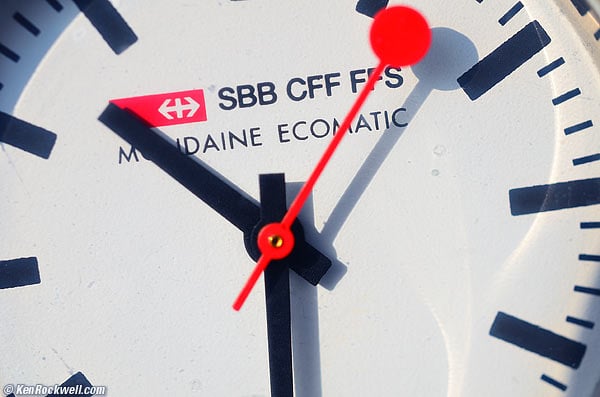
Nikon 40mm DX at 1:1 on DX.
The biggest technical problem in macro is keeping everything in exactly the same plane so it's in focus. In this example of a watch face, the face is in focus, but the hands are closer and not in focus — even at f/10 as shot here.
Practically, macro performance is awful: you have to get so close that it's nearly impossible to get out of the way of your own light. Forget trying to photograph live specimens at rest; the huge lens blocking the sun (from their perspective) will not exactly put them at ease.
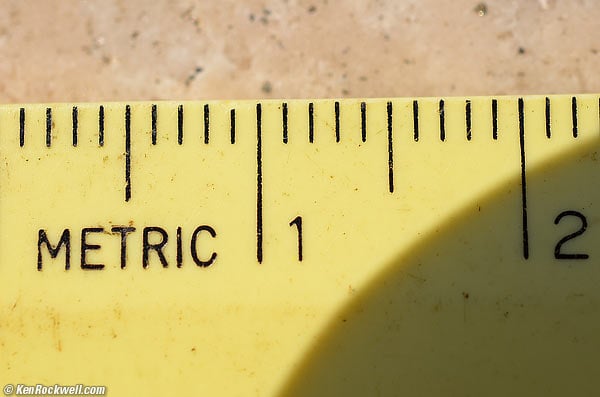
Nikon 40mm DX at 1:1 on DX.
As you can see here, it actually gets to a bit bigger than 1:1 (DX is 24mm wide), but the shadow is from the lens getting in the way of the sun.
Maximum and Minimum Apertures performance top
As with all macro lenses, they get slower as focused more closely.
As expected from an autofocus Nikon macro lens, the camera automatically compensates and reads accordingly.
You cannot set f/2.8 at close distances; this is normal. If you set f/2.8 at infinity. and focus more closely, the camera will indicate the actual aperture.
Repro Ratio |
Maximum Aperture |
∞ |
f/2.8 |
1:10 |
f/3 |
1:3 |
f/3.2 |
1:1 |
f/4.2 |
Minimum apertures reduce as well at close distances.
Mechanics and Construction performance top
Nikon 40mm f/2.8 DX. enlarge.
This 40mm DX is exactly like the other Chinese plastic lenses from Nikon like the much more expensive 50mm f/1.4: sturdy, light weight and functional.
Of course the glass is glass and the mount is metal, but everything else seems like plastic. It's good, solid and precise plastic.
Filter Threads
Plastic.
Hood
Plastic bayonet.
Hood Mount
Plastic.
Barrel Exterior
Plastic.
Focus Ring
Plastic; rubber covered.
Depth-of-Field Scale
None.
Aperture Ring
None.
Mount
Dull-chromed brass.
Markings
Paint.
Mounting Index Dot
White plastic ball.
Rain seal at mount
Yes.
Serial Number
Sticker glued into a recess on the bottom of the lens.
US Model Signified by
"US" prefix to serial number.
Made in
Weaknesses
It's pretty tough. I suspect the most delicate part is the front lens barrel which moves in and out as focused. Avoid hitting it on anything.
Sharpness performance top
Warning 1: Image sharpness depends more on you than your lens.
Warning 2: Lens sharpness doesn't mean much to good photographers.
With those caveats, the Nikon 40mm f/2.8 DX G AF-S is extremely sharp, even in the corners and even at f/2.8. Nikon doesn't make any sharper lenses.
Most macro lenses are the sharpest lenses you can get for any camera, and this 40mm DX is superb as expected.
The 40/2.8 DX Micro is sharp right out to the corners at f/2.8 on a DX 16 MP D7000. f/2.8 is only slightly less sharp than the optimum aperture, and not enough to be noticeable under anything but laboratory conditions.
f/4, f/5.6 and f/8 are optimum, presuming a perfectly flat subject.
By f/11 and smaller, diffraction is dulling the image slightly.
Of course for macro use with normal (three-dimensional) subjects, f/22 or f/32 is usually the best to try to keep things in focus. Figuring out the optimum aperture taking both diffraction and depth-of-field into account is beyond the scope of this review.
Nikon's claimed MTF curve.
This MTF curve says that it's extremely sharp, right out to the corners, even at f/2.8.
Sunstars performance top
With its semi-rounded 7-bladed diaphragm, it most likely will make soft 14-pointed sunstars on bright points of light.
Survivability performance top
The Nikon 40mm Macro is fairly tough.
Be careful not to bang the front on anything, and the only fear I'd have is is the AFS focus motor were to die and parts were not available in the future.
Compared top
Intro Specifications Performance Compared Usage Recommendations
I shot this 40mm lens on a 16 MP DX D7000 at the range against the Nikon 55mm f/2.8 AI-s and the Nikon 35mm f/1.8 DX. They were all super, duper sharp at all apertures from edge to edge. For DX, sharpness isn't an issue among these three lenses; eash is among Nikon's sharpest.
40mm f/2.8 DX |
||||||
| Covers | DX only |
DX only |
FX, DX and 35mm |
FX, DX and 35mm |
DX only |
FX, DX and 35mm |
| Filter | 52mm |
52mm |
62mm |
62mm |
52mm |
55mm |
| Close-focus | 0.5'/0.163m |
1'/0.3m |
0.7'/0.219m |
0.7'/0.219m |
1'/0.3m |
1'/0.3m |
| Clearance in front of lens at closest focus distance | 35mm (1.3") |
200mm (8") |
73mm (2.7") |
48mm (1.7") |
145mm (5.5") |
115mm (4.5") |
| Max. Repro Ratio | 1:1 |
1:6.1 |
1:1 |
1:1 |
1:1 |
1:1 |
| Minimum Subject Size (DX) | 16 x 24mm 0.6 x 1" |
98 x 147mm 3.8 x 5.7" |
16 x 24mm 0.6 x 1" |
16 x 24mm 0.6 x 1" |
16 x 24mm 0.6 x 1" |
16 x 24mm 0.6 x 1" |
| Diaphragm | 7 rounded |
7 rounded |
9 rounded |
9 rounded |
9 rounded |
9 straight |
| Optics | 9/7 |
8/6 ASPH |
8/7 |
12/9 ASPH |
14/10 |
9/8 |
| Weight* | 8.0 oz. 227g |
6.95 oz. 197g |
15.3 oz. 434g |
15.1 oz. 428g |
12.4 oz. 352g |
18.1 oz. 513g |
| Price |
* actual measured weights.
Usage top
Intro Specifications Performance Compared Usage Recommendations
Just grab and go.
Leave the "M/A - M" switch in M/A. For manual focus, just grab the ring. Use the "M" position if you want to disable autofocus.
If it takes longer than you'd like for autofocus to rack in and out, set the other switch to "∞ - 0.2m" to limit close-focus to 8 inches.
The maximum aperture is only f/2.8 at infinity, and less at closer distances. If you set f/2.8 and focus more closely, it's supposed to read a smaller aperture.
Recommendations top
Intro Specifications Performance Compared Usage Recommendations
The Nikon 40mm f/2.8 DX G AF-S is a fantastic normal lens with extreme close-focus ability. Get it if ultra-close focus ability is important to you in a normal lens.
This 40mm lens is not a good idea if you plan to use it for dedicated macro use. For serious macro use, get at least a 105mm macro lens for sanity's sake. Personally, I and everyone else serious about macro use 180mm or 200mm macro lenses.
For general use, I prefer the 35mm f/1.8 DX, which gets more than close enough, costs $80 less, and adds over a stop of needed speed for even better low-light results.
Nikon makes about 60 kinds of lenses because we all have different needs. This 40mm lens is best for someone needing a normal do-everything lens who values ultra-close focusing above low-light ability.
This 40mm DX has faultless optics in a tough and easy-to-use package at a low price. If you think you want one, you'll love it! Enjoy!
Deployment
I'd leave either a 52mm Nikon Clear (NC - UV) filter, or a 52mm Hoya Super HMC UV on the lens at all times.
I would leave the hood at home.
If I was working in nasty, dirty areas, I'd forget the cap, and use an uncoated 52mm Tiffen UV filter instead. Uncoated filters are much easier to clean, but more prone to ghosting.
More Information
Nikkor Full-Line Lens Brochure.
Help me help you top
I support my growing family through this website, as crazy as it might seem.
The biggest help is when you use any of these links when you get anything, regardless of the country in which you live. It costs you nothing, and is this site's, and thus my family's, biggest source of support. These places have the best prices and service, which is why I've used them since before this website existed. I recommend them all personally.
If you find this page as helpful as a book you might have had to buy or a workshop you may have had to take, feel free to help me continue helping everyone.
If you've gotten your gear through one of my links or helped otherwise, you're family. It's great people like you who allow me to keep adding to this site full-time. Thanks!
If you haven't helped yet, please do, and consider helping me with a gift of $5.00.
As this page is copyrighted and formally registered, it is unlawful to make copies, especially in the form of printouts for personal use. If you wish to make a printout for personal use, you are granted one-time permission only if you PayPal me $5.00 per printout or part thereof. Thank you!
Thanks for reading!
Mr. & Mrs. Ken Rockwell, Ryan and Katie.
Home Donate New Search Gallery Reviews How-To Books Links Workshops About Contact

